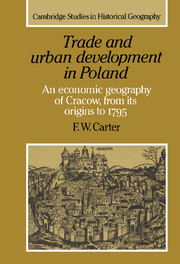Book contents
- Frontmatter
- Contents
- List of figures
- List of tables
- Preface
- Acknowledgements
- 1 Introduction: Cracow in context
- 2 Source materials and published literature
- 3 Cracow's early development
- 4 The political situation of Cracow, 1257–1500
- 5 European trade through Cracow, 1257–1500
- 6 The political situation of Cracow, 1500–1795
- 7 The commerce of Cracow, 1500–1795
- 8 Cracow: a final appraisal
- Appendix: Important dates in Cracow's history up to 1795
- Notes
- Select bibliography
- Index
- Cambridge Studies in Historical Geography
1 - Introduction: Cracow in context
Published online by Cambridge University Press: 07 October 2009
- Frontmatter
- Contents
- List of figures
- List of tables
- Preface
- Acknowledgements
- 1 Introduction: Cracow in context
- 2 Source materials and published literature
- 3 Cracow's early development
- 4 The political situation of Cracow, 1257–1500
- 5 European trade through Cracow, 1257–1500
- 6 The political situation of Cracow, 1500–1795
- 7 The commerce of Cracow, 1500–1795
- 8 Cracow: a final appraisal
- Appendix: Important dates in Cracow's history up to 1795
- Notes
- Select bibliography
- Index
- Cambridge Studies in Historical Geography
Summary
Cracow, ancient capital of Poland, today represents a lively industrial, scientific and cultural centre. It is a city of priceless relics and monuments to Poland's national culture which miraculously have survived the disasters of war; the oldest documentary sources date from the mid-tenth century, and describe the city as an important commercial centre on the Vistula river, at the junction of several great international trade routes leading from Southern Europe to the Baltic Sea, and from the countries of the Near East, via Silesia to Western Europe.
Whilst it would be wrong to overemphasize the role of geographical conditions in the development of this city, it should be remembered that they played a significant part in Cracow's destiny through their influence on human activity both within Poland and against the wider background of the European continent. The city was surrounded by hills, of which on one limestone outcrop named Wawel its first settlement was located, seventy-five feet above the large river Vistula. From here the outlying countryside could be observed, rich in natural resources and with its fertile soil suitable for grain production; likewise fruit and vegetable growing was also pursued whilst the large forests were full of game. Timber was plentiful, as was clay and building stone. From the city's early days iron-, lead-, silver- and even gold-ore were exploited locally, together with rock salt from nearby Wieliczka, a commodity always high in demand.
All these initial advantages contributed to a rapid growth of Cracow in the Early Middle Ages, when it became one of the residential seats of the Polish kings under the Piast dynasty.
- Type
- Chapter
- Information
- Trade and Urban Development in PolandAn Economic Geography of Cracow, from its Origins to 1795, pp. 1 - 17Publisher: Cambridge University PressPrint publication year: 1994



